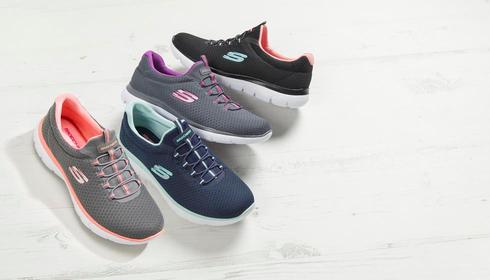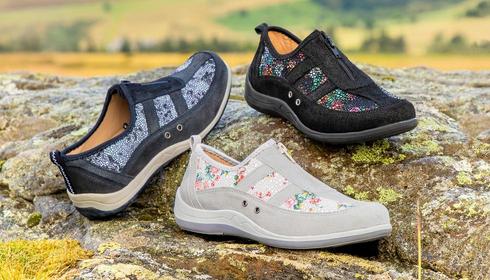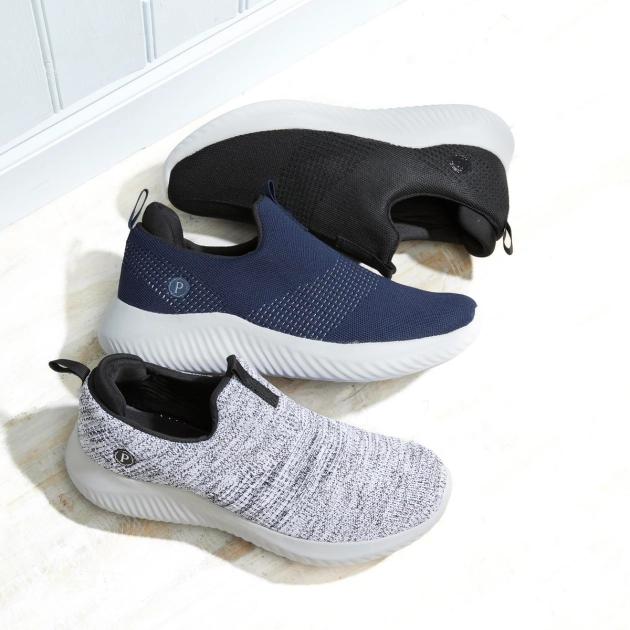
What Are the Best Trainers for Walking?
13 May 2021
When walking long distances you need the shoes and trainers that will go the extra mile, but did you know you can use trainers as walking shoes? The best walking shoes don’t necessarily have to be walking boots, a pair of trainers have a of number performance benefits that will keep your feet happy and comfortable when counting your steps.
When out and about you need a pair of walking trainers that will be supportive, so, there’s plenty to consider, from shock-absorbing soles to gripped and flexible designs, lace-up and slip-on trainers, lightweight and breathable styles.
So, to give you a helping hand we have put together a need-to-know guide should you be pondering whether to reach for your walking boots or trainers.
Are Walking Boots Better than Trainers?

Whether you're setting off for a brisk city stroll or conquering rugged trails, the footwear you choose can make or break your experience. Walking boots and trainers, each with their distinct merits, are commonly debated choices for walking enthusiasts.
Trainers are adored for their lightweight soles. Over long treks and distances, this reduced foot fatigue can be a true game-changer. Your feet naturally bear the weight of your entire body, so imagine adding the strain of cumbersome shoes to a day-long walk! Trainers, with their featherlight designs, alleviate this concern significantly.
Furthermore, trainers are crafted with flexibility in mind. This ensures that with each step you take, the shoe moves seamlessly with the contours of your foot. Such flexibility not only aids in the natural movement of your step but also offers commendable grip underfoot. This makes them particularly handy for flat terrains or even urban landscapes.

However, it's worth noting that trainers are primarily designed for high-impact activities like running or jogging. This means they inherently possess certain features beneficial to walkers. Their grip is quite similar to many walking boots, ensuring stability. Moreover, the cushioned linings in trainers aim at providing optimal comfort, so your feet feel pampered, even on longer jaunts.
On the other hand, walking boots have their own set of advantages, primarily revolving around support and durability. They're often more robust and provide excellent ankle support, making them ideal for uneven terrains or more challenging hikes.
In conclusion, while trainers offer lightweight flexibility perfect for flat surfaces or shorter walks, walking boots provide the stability and support needed for more rugged adventures. As always, at Pavers, we believe in equipping you with both style and comfort, regardless of your choice. After all, every journey is unique, and so should be your footwear!
Can Trainers be Used as Walking Shoes?

Trainers make the ideal walking shoes for shorter walks and gentle strolls, whilst walking shoes and boots offer a practical option for hiking and rougher terrains. For the savvier walkers amongst us, trainers offer a cheaper alternative to walking shoes, plus they’ll go further should you want to wear them for other activities. It is important that you choose the right trainers to prevent injury and make walking more enjoyable and comfortable too.
While walking boots and trainers may hold many similarities, it is important to find trainers that will provide the most suitable support and of course, keep you feeling comfortable. So, whether you’re on an afternoon stroll to top up your step count or you’re hitting the trail on a high-impact adventure you need the footwear that caters to the demands they put on your feet.

But how do you choose the walking trainers to reflect these differences?
Most runners land on their heel, midfoot, or ball of their foot and walkers will land on their heel and then roll their step through to the toe, this gentle walking motion will allow your feet to absorb 1.5 times your body weight and distribute it evenly on the foot.
When you run, 3 times the weight of your body is absorbed through your feet, so in general running shoes have more cushioning in the heel bed and at the ball of the foot.
Heel Shapes:
To help your feet naturally roll forward avoid flared or overly large heels and look for soles with an even height between the heel and toes.
Flexibility:
When walking, you need to push off into your step with your toes, so invest in a pair with greater flexibility around the ball and the arch of your foot.
Cushioning:
When you walk, initially you step on the ball of your foot, so a good pair of walking trainers will need cushioning in the footbed to absorb and redistribute your weight evenly across your feet.
Arch Support:
The arch of your foot will absorb the most amount of impact when you step, so look for a trainer with cushioned arch support.
Are Trainers Good for Hiking?
Hiking in trainers might seem like an unconventional idea for the more seasoned walker but there are many positive benefits for ditching your boots for your running shoes!
The more weight that you carry on your feet, the more energy you exert, 4-6 times more energy to be precise, so keeping light on your feet might just add a few more miles to your next outdoor adventure.
Walking boots can be demanding, they need time to break in to prevent the risk of blisters and sore rubbed feet, plus soles can feel rather clunky at times which can impact on your movement and stability.
However, before you head outdoors it is important to consider whether walking boots or trainers are the most suited footwear for the type of walk you plan to make, if you are adventuring onto extremely rough terrain or into deep snow, hiking boots provide essential stability and support, especially around your ankles.
What to Look For in Walking Trainers
Comfort is key where walking is concerned, you don’t want shoes that will pinch your feet or weigh you down when you’re trekking to your favourite beauty spot. So, you need trainers that will put a spring in your step whilst keeping you supported and comfortable
So, what features should you look out for when walking long distances in trainers?
Flexibility:
Unlike hard soles, you need walking shoes that will flex with your feet as you step and enable you to gain grip on rough terrain.
Breathability:
Sport knit uppers are great for breathability and flexibility too. Good ventilation will reduce the risk of sweaty feet which can lead to rubbed feet and consequently blisters
Adjustability:
Through longer walks, you will find that your feet tend to swell, it’s a good idea to invest in a pair of lace-up trainers, so you can alter the fit during your hike.
Thick soles:
Your trainers should be light and flexible with soles that are thick enough to prevent stones being felt under your feet.
Our Picks

Our Wide-Fit Lightweight Slip-On Trainers seamlessly blend comfort with style, ensuring every step you take is a breeze. Crafted for those who value both elegance and functionality, these trainers feature a wide-fit design, ensuring ample space and comfort for your feet. The lightweight nature of these trainers makes them perfect for extended strolls, ensuring minimal foot fatigue. Furthermore, the slip-on design promises convenience, allowing you to get moving without the fuss of laces. Tailored for walking enthusiasts, these trainers are the ideal blend of practicality and modern aesthetics, making them a must-have for anyone seeking the perfect walking companion.

Perfectly tailored for those who appreciate both chic design and day-long comfort, these trainers stand out with their modern silhouette. Their lightweight construction ensures every step feels effortless, making them ideal for both spontaneous jaunts and planned excursions. Their slip-on design adds a layer of convenience, eliminating any lace-up hassles and providing an easy, snug fit. The subtle texture and stylish accents not only enhance the aesthetic appeal but also offer a touch of elegance to your casual wear. For those who seek a fusion of contemporary style and unparalleled comfort in their footwear, these trainers are a top-notch choice.
Be Inspired
Check out our latest blogs.

